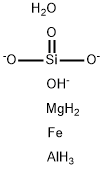
Вермикулит
- английское имяVERMICULITE
- CAS №1318-00-9
- CBNumberCB7312881
- ФормулаAlFeH8MgO5Si-3
- мольный вес223.28
- номер MDLMFCD00132837
- файл Mol1318-00-9.mol
химическое свойство
| Температура плавления | 1350 °C |
| плотность | 2.4~2.7g/cm3 |
| цвет | Tan |
| Стабильность | Stable. |
| Рейтинг продуктов питания EWG | 1 |
| Система регистрации веществ EPA | Vermiculite (1318-00-9) |
| UNSPSC Code | 12000000 |
| NACRES | SB.52 |
рисовальное письмо(GHS)
-
рисовальное письмо(GHS)

-
сигнальный язык
предупреждение
-
вредная бумага
H319:При попадании в глаза вызывает выраженное раздражение.
H335:Может вызывать раздражение верхних дыхательных путей.
-
оператор предупредительных мер
P264:После работы тщательно вымыть кожу.
P280:Использовать перчатки/ средства защиты глаз/ лица.
P305+P351+P338:ПРИ ПОПАДАНИИ В ГЛАЗА: Осторожно промыть глаза водой в течение нескольких минут. Снять контактные линзы, если Вы ими пользуетесь и если это легко сделать. Продолжить промывание глаз.
Вермикулит химические свойства, назначение, производство
Использование
As catalyst; loose fill insulation, filler and packing material.Сельскохозяйственное использование
Vermiculite is a clay mineral. It is similar to trioctahedral smectites, with a structure that is balanced by interlayer ions of mostly magnesium and sometimes calcium. In other words, vermiculite is a hydrated silicate, which results from the alteration of mica, especially an aluminosilicate of magnesium. The formula of vermiculite is:Vermiculite is a tri-octahedral phyllite (2: 1) with a basal spacing of lOA varying between 1A and lOA, according to the nature of the interlayer cations. The following are the principal differences between vermiculites and smectites. (i) Vermiculites have a large grain size. (ii) Vermiculites have a higher cation exchange capacity and, when treated with glycol, achieve basal spacing of about 14A while smectites take double layers, with a basal spacing swelling to 17A. (iii) Smectites dehydrate more rapidly while vermiculites rehydrate more rapidly.
In soils, vermiculites are mostly clays of transformation, formed from the degradation of micas or illites. They have a high cation exchange capacity (CEC) of 100 to 150 meq/100 g, which endows them a high affity for weakly hydrated ions such as K+, N&+ and Caz+. Consequently, vermiculite-rich soils exhibit high potassium-fixation capacity.
Vermiculite does not swell as much as montmorillonite. Vermiculite is a 2:1 clay mineral, similar in structure to hydrous magnesium. On rapid heating, vermiculite assumes a worm-like shape, alluding to a peculiar exfoliation phenomenon. When heated, it can also expand to a lightweight, highly absorbent, fireproof material about 16 times its original volume. In natural state, the mineral has no useful application, but it provides a low-density material with excellent thermal and acoustic insulation properties when exfoliated. Vermiculites in flakes are useful as a medium for growing tissue-culture plants and for insulation.
Вермикулит запасные части и сырье
сырьё
Вермикулит поставщик
| поставщик | телефон | страна | номенклатура продукции | благоприятные условия |
|---|---|---|---|---|
| +86-29-81148696 +86-15536356810 |
China | 3882 | 58 | |
| +86-17736087130 +86-18633844644 |
China | 994 | 58 | |
| +86-0371-55170693 +86-19937530512 |
China | 21632 | 55 | |
| 571-88938639 +8617705817739 |
China | 52849 | 58 | |
| +8618058761490 | China | 49983 | 58 | |
| +86-852-30606658 | China | 43340 | 58 | |
| +86-18621343501; +undefined18621343501 |
China | 33338 | 58 | |
| +8613817748580 | China | 40066 | 58 | |
| 400-6009262 16621234537 |
China | 14103 | 59 | |
| 1-631-485-4226; 16314854226 |
United States | 14055 | 65 |